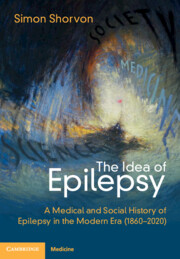Book contents
- The Idea of Epilepsy
- The Idea of Epilepsy
- Copyright page
- Dedication
- Contents
- Preface
- Section 1 The Voyage Of The Good Ship Epilepsy
- Section 2 ‘A Plague upon Your Epileptic Visage’
- One 1860–1914: The Birth of Modern Epilepsy
- Two 1914–1945: Epilepsy in the Age of Catastrophe
- Three 1945–1970: Epilepsy and the New World Order
- Four 1970–1995: Epilepsy in a Globalised World
- Five 1995–2020: The Epilepsy Floods are Too Recent
- Section 3 Epilepsy: The Paradigm of the Suffering of Both Body and Soul in Disease
- Book part
- Glossary
- Bibliography
- Index of Names
- Index
Three - 1945–1970: Epilepsy and the New World Order
from Section 2 - ‘A Plague upon Your Epileptic Visage’
Published online by Cambridge University Press: 13 January 2023
- The Idea of Epilepsy
- The Idea of Epilepsy
- Copyright page
- Dedication
- Contents
- Preface
- Section 1 The Voyage Of The Good Ship Epilepsy
- Section 2 ‘A Plague upon Your Epileptic Visage’
- One 1860–1914: The Birth of Modern Epilepsy
- Two 1914–1945: Epilepsy in the Age of Catastrophe
- Three 1945–1970: Epilepsy and the New World Order
- Four 1970–1995: Epilepsy in a Globalised World
- Five 1995–2020: The Epilepsy Floods are Too Recent
- Section 3 Epilepsy: The Paradigm of the Suffering of Both Body and Soul in Disease
- Book part
- Glossary
- Bibliography
- Index of Names
- Index
Summary
The pace of basic and clinical science increased dramatically in this period, boosted by an enormous increase in funding, especially in the USA. The pharmaceutical industry developed strongly and a range of new drugs were introduced for epilepsy, including ethosuximide, carbamazepine, valproate and the benzodiazepines. Pharmacokinetic principles were introduced into clinical prescribing. Specialism in medicine developed strongly and neurology took over from psychiatry as the primary specialty of epilepsy. Temporal lobe epilepsy was identified as an important form of epilepsy, the relevance of hippocampal sclerosis was recognised and temporal lobectomy was introduced. The ILAE became an important force in epilepsy with the introduction of its classification of seizure types. The ‘welfare state’ provided access to modern medical care for all patients with epilepsy for the first time in history. Institutionalisation greatly diminished. The stigma of epilepsy began to lessen in the era of liberalism and social democratic principles; social attitudes towards epilepsy greatly improved, as did the position of those handicapped by epilepsy with the disability rights movement. The patients’ voice was beginning to be heard, legislation was adopted protecting the rights of people with epilepsy, epilepsy featured in film/TV and new patient associations were formed including the IBE.
Keywords
- Type
- Chapter
- Information
- The Idea of EpilepsyA Medical and Social History of Epilepsy in the Modern Era (1860–2020), pp. 262 - 395Publisher: Cambridge University PressPrint publication year: 2023



